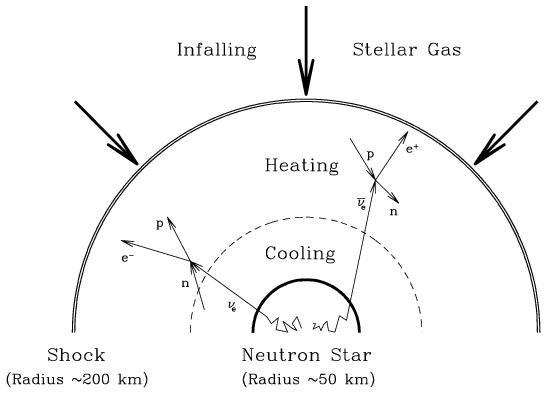How do Massive Stars Explode? |
A simple, analytic model was developed at the Max-Planck-Institute for Astrophysics to discuss the complex processes which cause the supernova explosions of massive stars. The model helps one understanding the role of neutrinos for the explosion, and supplements more detailed, but also less transparent, supercomputer calculations.
Stars with masses of roughly more than ten times the mass of our Sun end their lives in spectacular supernova explosions, which can outshine a whole galaxy for a period of several weeks. Stellar fragments are ejected at a tenth of the speed of light and heavy elements, bred by the star during millions of years of quiet nuclear burning, and radioactive nuclei, freshly produced during the early moments of the explosion, are swept into the circumstellar space to form the seed of a new generation of stars and planets.
As brilliant as it may be, such a catastrophic disruption of a star is only a weak side effect of a much more energetic event: The iron core of the massive star collapses to a neutron star or a black hole, a compact remnant only 20 kilometers in size, which is left behind at the center of the diffuse nebula of expanding stellar gas. In this process ten thousand times more energy than radiated in photons is liberated in neutrinos, elementary particles which are abundantly produced by particle reactions inside the hot, nascent neutron star.

|
| Figure 1: Competing processes that determine the destiny of the supernova shock: Gas infall from the collapsing star damps shock expansion. The gas between the neutron star and the shock is cooled and heated by neutrinos. Only when the neutrino heating is strong enough, an explosion can be triggered. |
Although these neutrinos interact only very weakly with the stellar gas around the neutron star, they can deposit enough energy within the innermost few hundred kilometers to power the explosion of the star. The involved complex processes are not satisfactorily understood. Hydrodynamic simulations, using large computer codes on top-end supercomputers, yield no clear picture how and why the explosion is initiated. It is of fundamental importance to deepen our insight into the mechanism of the explosion, because important questions are inseparably linked to it, e.g., whether a neutron star or a black hole is formed and how much radioactive material is produced by the supernova.
A simple analytic model was therefore developed at the Max-Planck-Institute for Astrophysics recently, which can help illuminating the crucial physics behind the explosion mechanism. Shortly after its formation, the supernova shock is exposed to competing effects: Gas infall above the shock, which depends on the structure of the collapsing star, and neutrino heating as well as cooling below the shock, which are affected by the neutrino luminosity streaming out from the nascent neutron star (Fig. 1). Only for a suitable combination of these conditions can the shock continue to expand and will eventually be able to receive enough energy for disrupting the star (Fig. 2).
|
||
| Figure 2: Left plot: Phase diagram for successful explosion or continued stellar collapse in dependence upon the rate at which gas falls into the shock and upon the neutrino luminosity of the nascent neutron star. The mass of the neutron star was assumed to be 1.25 solar masses. Right plot: Shock positions as functions of time for different values of the neutrino luminosity of the neutron star (according to labels) and fixed value of the rate at which gas falls into the shock (marked by the dashed line in the left plot). For neutrino luminosities above the critical value (where the dashed line crosses the solid line in the left plot) explosions can occur. |
In particular, a sufficiently high core luminosity is important. On the one hand this increases the neutrino energy deposition in the heating layer, on the other hand a high core luminosity reduces the energy loss from the cooling layer. The latter effect is even more important because it prevents gas from falling onto the neutron star very quickly before efficient energy absorption from neutrinos can take place. The analytic model also demonstrates that neutrino-powered explosions are limited in energy to some 1051 erg - a typical value for the explosion of a massive star. This is so because the nucleons expand away from the heating layer as soon as they have absorbed enough energy from neutrinos to escape the gravitational pull of the neutron star.
The analytic discussion can therefore bracket the conditions where hydrodynamic models should be able to find explosions. Moreover, it has led to general statements about the properties of neutrino-driven supernova explosions.
H.-Thomas Janka
Further information:
| MPA-Home |